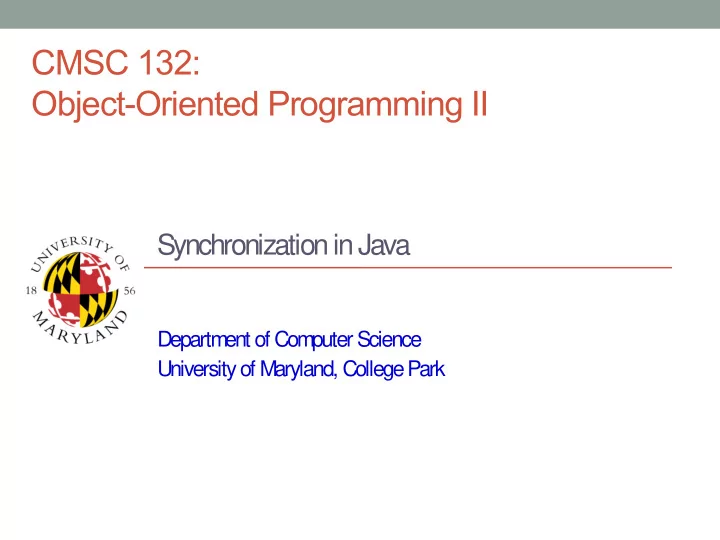

CMSC 132: Object-Oriented Programming II Synchronization in Java Department of Computer Science University of Maryland, College Park
Data Race • Definition Concurrent accesses to same shared variable, where at least one – access is a write • Properties – Order of accesses may change result of program – May cause intermittent errors, very hard to debug • Example public class DataRace extends Thread { static int x; // shared variable x causing data race public void run() { x = x + 1; } // access to x }
Synchronized Objects in Java • Every Java object has a lock – A lock can be held by only one thread at a time • A thread acquires the lock by using synchronized • Acquiring lock example Object x = new Object(); // We can use any object as “locking object” synchronized(x) { / / try to acquire lock on x on entry ... // hold lock on x in block } // release lock on x on exit • When synchronized is executed Thread will be able to acquire lock if no other thread has it – Thread will block if another thread has the lock (enforces mutual exclusion) – • Lock is released when block terminates End of synchronized block is reached – Exit block due to return, continue, break – – Exception thrown
Example (Account) • We have a bank account shared by two kinds of buyers (Excessive and Normal) • We can perform deposits, withdrawals and balance requests for an account • Critical section account access • Solution (Example: lockObjInAccount) We are using lockObj to protect access to the Account object – – What would happen if we define lockObj as static? Can we have multiple accounts? • Solution (Example: usingThisInAccount) Notice we don’t need to define an object to protect the Account – object as Account already has a lock
Synchronized Methods In Java • If the entire body of a method is synchronized using the current object lock (e.g., synchronized(this)) then we can rewrite the code by using the synchronized keyword on the method prototype • Example synchronized foo() { …code… } // shorthand notation for foo() { synchronized (this) { …code… } } • Example: synchronizedMethods • Mutual exclusion for entire body of method
Synchronization Issues Use same lock to provide mutual exclusion 1. Ensure atomic transactions 2. Avoiding deadlock 3.
Issue 1- Using Same Lock • Potential problem Mutual exclusion depends on threads acquiring same lock – No synchronization if threads have different locks – • Example foo() { Object o = new Object(); // different o per thread synchronized(o) { … // potential data race } }
Locks in Java • Single lock for all threads (mutual exclusion) • Separate locks for each thread (no synchronization)
Lock Example – Incorrect Version public class DataRace extends Thread { static int common = 0; public void run() { Object o = new Object(); // different o per thread synchronized(o) { int local = common; // data race local = local + 1; common = local; // data race } } public static void main(String[] args) { … } }
Issue 2- Atomic Transactions • Potential problem Sequence of actions must be performed as single atomic – transaction to avoid data race Ensure lock is held for duration of transaction – • Example synchronized(o) { int local = common; // all 3 statements must local = local + 1; // be executed together common = local; // by single thread }
Lock Example – Incorrect Version public class DataRace extends Thread { static int common = 0; static Object o; // all threads use o’s lock public void run() { int local; synchronized(o) { local = common; } // transaction not atomic synchronized(o) { // data race may occur local = local + 1; // even using locks common = local; } } }
Issue 3- Avoiding Deadlock • Potential problem – Threads holding lock may be unable to obtain lock held by other thread, and vice versa – Thread holding lock may be waiting for action performed by other thread waiting for lock – Program is unable to continue execution (deadlock)
Deadlock Example 1 Object a = new Object() Object b = new Object() Thread1() { Thread2() { synchronized(a) { synchronized(b) { synchronized(b) { synchronized(a) { … … } } } } } } // Thread1 holds lock for a, waits for b // Thread2 holds lock for b, waits for a
Deadlock Example 2 void swap(Object a, Object b) { Object local; synchronized(a) { synchronized(b) { local = a; a = b; b = local; } } } Thread1() { swap(a, b); } // holds lock for a, waits for b Thread2() { swap(b, a); } // holds lock for b, waits for a
Deadlock • Avoiding deadlock – In general, avoid holding lock for a long time – Especially avoid trying to hold two locks ● May wait a long time trying to get 2nd lock
Thread-safe • Thread-safe Code is considered thread-safe if it works correctly when executed by multiple threads simultaneously. • Example: ArrayList is not thread-safe From Java API: “Note that this implementation is not synchronized. If multiple threads access an ArrayList instance concurrently, and at least one of the threads modifies the list structurally, it must be synchronized externally.”
Miscellaneous • The lock we have described is known as intrinsic lock or monitor lock API specification often refers to this entity simply as a "monitor“ – • A lock can acquire a lock it already owns (it will not block) – Reentrant synchronization • For a static synchronized method which lock is used? Thread acquires the intrinsic lock for the Class object associated with – the class • Reference: http:// – docs.oracle.com/javase/tutorial/essential/concurrency/locksync.html
Synchronization Summary • Needed in multithreaded programs • Can prevents data races • Java objects support synchronization • Many other tricky issues To be discussed in future courses –
Recommend
More recommend